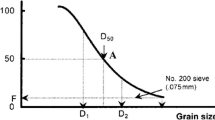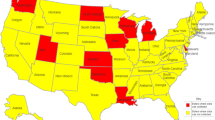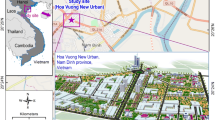Abstract
The present study assesses the use of support vector machine regression to predict the variation of resilient modulus with post-compaction moisture content of soils commonly encountered in Oklahoma, Pennsylvania and Wisconsin. Results show the prediction model using the support vector regression (SVR) approach is a function of degree of saturation, moisture content and plasticity index. The developed model is compared to current models in the literature. Results indicate the proposed SVR model gives more accurate values than current regression models. This model will better predict changes in the bearing capacity of pavements due to seasonal variations of moisture content.








Similar content being viewed by others
References
Brooks RM, Cetin M (2012) Application of construction demolition waste for improving performance of subgrade and subbase layers. Int J Res Rev Appl Sci 12(3):375–381
Brooks RM, Cetin M (2013) Water susceptible properties of silt loam soil in subgrades in South West Pennsylvania. Int J Modern Eng Res 3(2):57, 944–948, ISSN: 2249-6645, March–April 2013
Cary CE, Zapata CE (2009) Enhancement of the model for resilient response of soils due to seasonal environmental changes implemented in the M-E PDG. Transportation Research Board, Annual Meeting CD-ROM, Paper 09-3199. http://docs.trb.org/prp/09-3199.pdf
Cary C, Zapata C (2010) Enhanced model for resilient response of soils resulting from seasonal changes as implemented in mechanistic-empirical pavement design guide. Transp Res Rec J Transp Res Board 2170:36–44
Cetin M (2013) Pavement design with porous asphalt. Ph.D. thesis, Temple University, USA
Chang CH, Lin C-J (2011) LIBSVM: a library for support vector machines. ACM Trans Intell Syst Technol 2:27:1–27:27. http://www.csie.ntu.edu.tw/~cjlin/libsvm
Das SK, Samui P, Sabat AK (2012) Prediction of field hydraulic conductivity of clay liners using an artificial neural network and support vector machine. Int J Geomech 12(5):606–611
Drumm EC, Reeves JS, Madgett MR, Trolinger WD (1997) Subgrade resilient modulus correction for saturation effects. J Geotech Geo-environ Eng 123(7):663–670
Han Z, Vanapalli SK (2015) Model for predicting resilient modulus of unsaturated subgrade soil using soil-water characteristic curve. Can Geotech J 52:1605–1619
Khosravifar S, Afsharikia Z, Schwartz CW (2015) Evaluation of resilient modulus prediction models for cohesive and noncohesive soils. In: Proceedings of the Airfield and highway pavement ASCE 2015, Miami, Florida, pp 778–788
Khoury NN, Zaman M (2004) Correlation among resilient modulus, moisture variation, and soil suction for subgrade soils. Transp Res Rec J Transp Res Board 1874:99–107
Khoury NN, Brooks R, Zaman M, Khoury CN (2009) Variations of resilient modulus of sub-grade soils with post-compaction moisture content. Transp Res Rec J Transp Res Board 2101:72–81
Khoury CN, Khoury NN, Miller G (2011) Effect of cyclic suction history (hydraulic hysteresis) on resilient modulus of unsaturated fine-grained soil. Transp Res Rec J Transp Res Board 2232:68–75
Khoury NN, Brooks R, Khoury CN (2013) MR-moisture relationships for unsaturated subgrade soils. In: Proceedings of transportation research board annual meeting (CD-ROM)
Lee Y, Lee C (2003) Classification of multiple cancer types by multicategory support vector machines using gene expression data. Bioinformatics 19:1132–1139
Li D, Selig ET (1994) Resilient modulus for fine-grained subgrade soils. J Geotech Geoenviron Eng 120(6):939–957
Liang RY, Rabab’ah S, Khasawneh M (2008) Predicting moisture dependent resilient modulus of cohesive soils using soil suction concept. J Transp Eng 134(1):30–40
Maalouf M, Homouz D (2014) Kernel ridge regression using truncated newton method. Knowl Based Syst 71:339–344
Maalouf M, Khoury NN, Trafalis TB (2008) Support vector regression to predict asphalt mix performance. Int J Numer Anal Meth Geomech 32:1989–1996
Maalouf M, Khoury NN, Laguros JG, Kumin H (2012) Support vector regression to predict the performance of stabilized aggregate bases subject to wet–dry cycles. Int J Numer Anal Methods Geomech 36:675–696
Pal M (2006) Support vector machines-based modelling of seismic liquefication potential. Int J Numer Anal Methods Geomech 30:983–996
Samui P, Sitharam TG, Kurup PU (2008) OCR prediction using support vector machine based on piezocone data. J Geotech Geoenviron Eng 134(6):894–898
Sivakumar V, Kodikara J, O’Hagan R, Hughes D, Cairns P, McKinley JD (2013) Effects of confining pressure and water content on performance of unsaturated compacted clay under repeated loading. Geotechnique 63(8):628–640
Titi HH, Elias MB, Helwany S (2006) Determination of typical resilient modulus values for selected soils in wisconsin. Final report, Submitted to Wisconsin Department of Transportation, WHRP 0092-03-11
Trafalis TB, Ince H (2000) Support vector machine for regression and applications to financial forecasting. In: Proceedings of the IEEE-INNS-ENNS international joint conference on neural networks, vol 6, pp 348–353
Trafalis TB, Ince H, Richman H (2003) Tornado detection with support vector machines. In: Proceedings of international conference on computational science, pp 289–298
Vapnik V (1995) The nature of statistical learning. Springer, New York
Yang SJ, Huang WH, Tai YT (2004) Variation of resilient modulus with soil suction for compacted subgrade soils. Transp Res Rec J Transp Res Board 1913:99–106
Yang SR, Lin HD, Kung JHS, Huang WH (2008) Suction-controlled laboratory test on resilient modulus of unsaturated compacted subgrade soils. J Geotech Geoenviron Eng 134(9):1375–1384
Yuan D, Nazarian S (2003) Variation in moduli of base and subgrade with moisture. In: Proceedings of the 2003 annual transportation research board annual meeting, Washington
Author information
Authors and Affiliations
Corresponding author
Rights and permissions
About this article
Cite this article
Khoury, N., Maalouf, M. Prediction of Resilient Modulus from Post-compaction Moisture Content and Physical Properties Using Support Vector Regression. Geotech Geol Eng 36, 2881–2892 (2018). https://doi.org/10.1007/s10706-018-0510-2
Received:
Accepted:
Published:
Issue Date:
DOI: https://doi.org/10.1007/s10706-018-0510-2




